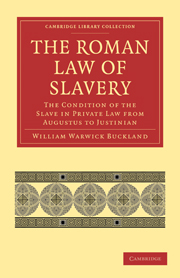Book contents
- Frontmatter
- PREFACE
- Contents
- ERRATA, ADDENDA, AND LIST OF ABBREVIATIONS
- LIST OF PRINCIPAL ABBREVIATIONS
- PART I CONDITION OF THE SLAVE
- PART II ENSLAVEMENT AND RELEASE FROM SLAVERY
- APPENDIX I The relation of the contractual actions adiectitiae qualitatis to the Theory of Representation
- APPENDIX II Formulation and Litis Consumptio in the actions adiectitiae qualitatis
- APPENDIX III Form used by Slave in acquisition by Mancipatio, etc.
- APPENDIX IV The essential character of Manumission: Iteratio
- APPENDIX V Manumission vindicta by a, filiusfamilias
- INDEX
APPENDIX III - Form used by Slave in acquisition by Mancipatio, etc.
Published online by Cambridge University Press: 07 September 2010
- Frontmatter
- PREFACE
- Contents
- ERRATA, ADDENDA, AND LIST OF ABBREVIATIONS
- LIST OF PRINCIPAL ABBREVIATIONS
- PART I CONDITION OF THE SLAVE
- PART II ENSLAVEMENT AND RELEASE FROM SLAVERY
- APPENDIX I The relation of the contractual actions adiectitiae qualitatis to the Theory of Representation
- APPENDIX II Formulation and Litis Consumptio in the actions adiectitiae qualitatis
- APPENDIX III Form used by Slave in acquisition by Mancipatio, etc.
- APPENDIX IV The essential character of Manumission: Iteratio
- APPENDIX V Manumission vindicta by a, filiusfamilias
- INDEX
Summary
In an essay in the Zeitschrift der Savigny Stiftung for 1905 with the chief thesis of which we are not here concerned, Professor Eisele makes some interesting remarks on the form of mancipatio. As Gaius shews, it contained in ordinary cases, two members; first an assertion of ownership in the acquirer, and secondly, what looks like the chief operative part, esto mihi empta hoc aere aeneaque libra. With the odd fact that at the time when the assertion of ownership is made it is not true we need not here deal. Our difficulty is to see how far the form was modified if the acquisition was by a slave. It is clear that he could say hanc rem domini mei ex iure Quiritium ease aio. But he did not always say this, as there might be doubt as to the person to whom he acquired, e.g. in the case of usufruct. Eisele thinks that he said meum ease aio. This is improbable on the face of it, and cannot really be made to agree with the remark of Gaius that the reason why he could not claim in a cessio in iure was that he could have nothing of his own. Eisele supposes that Gaius is really referring to incapacity to appear in court, but that is not what Gaius says, and it is scarcely credible that he could have expressed himself as he does, if slaves had been constantly using that exact formula in mancipatio. Eisele adverts to the well-known rule laid down, e.g. by Julian, that a slave could stipulate sibi dari. But Julian is also clear that a slave cannot stipulate for a right for himself.
- Type
- Chapter
- Information
- The Roman Law of SlaveryThe Condition of the Slave in Private Law from Augustus to Justinian, pp. 712 - 713Publisher: Cambridge University PressPrint publication year: 2010First published in: 1908



